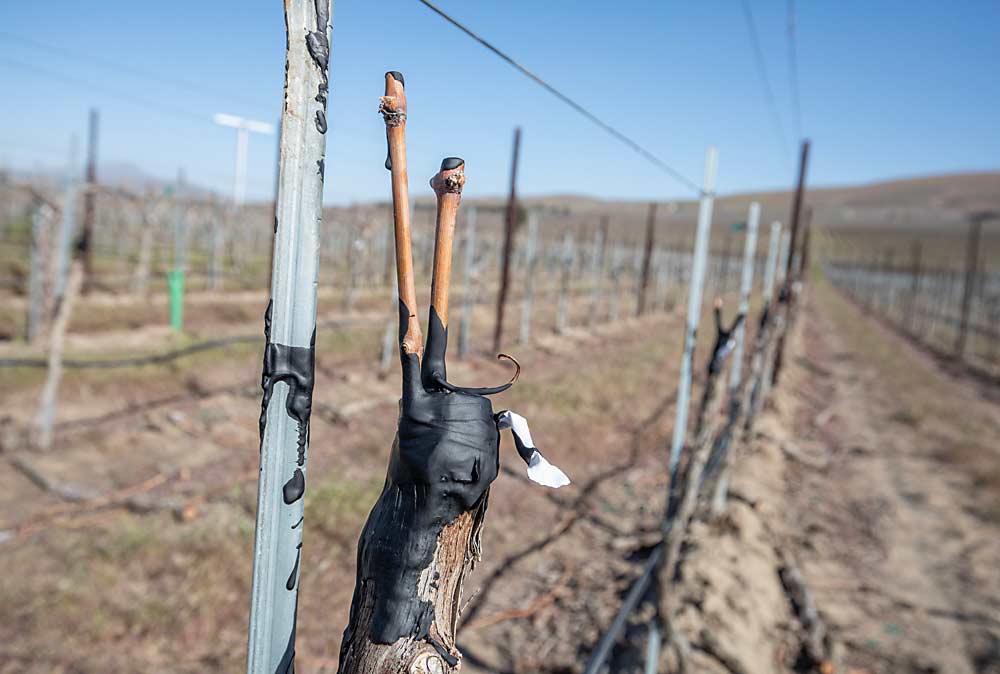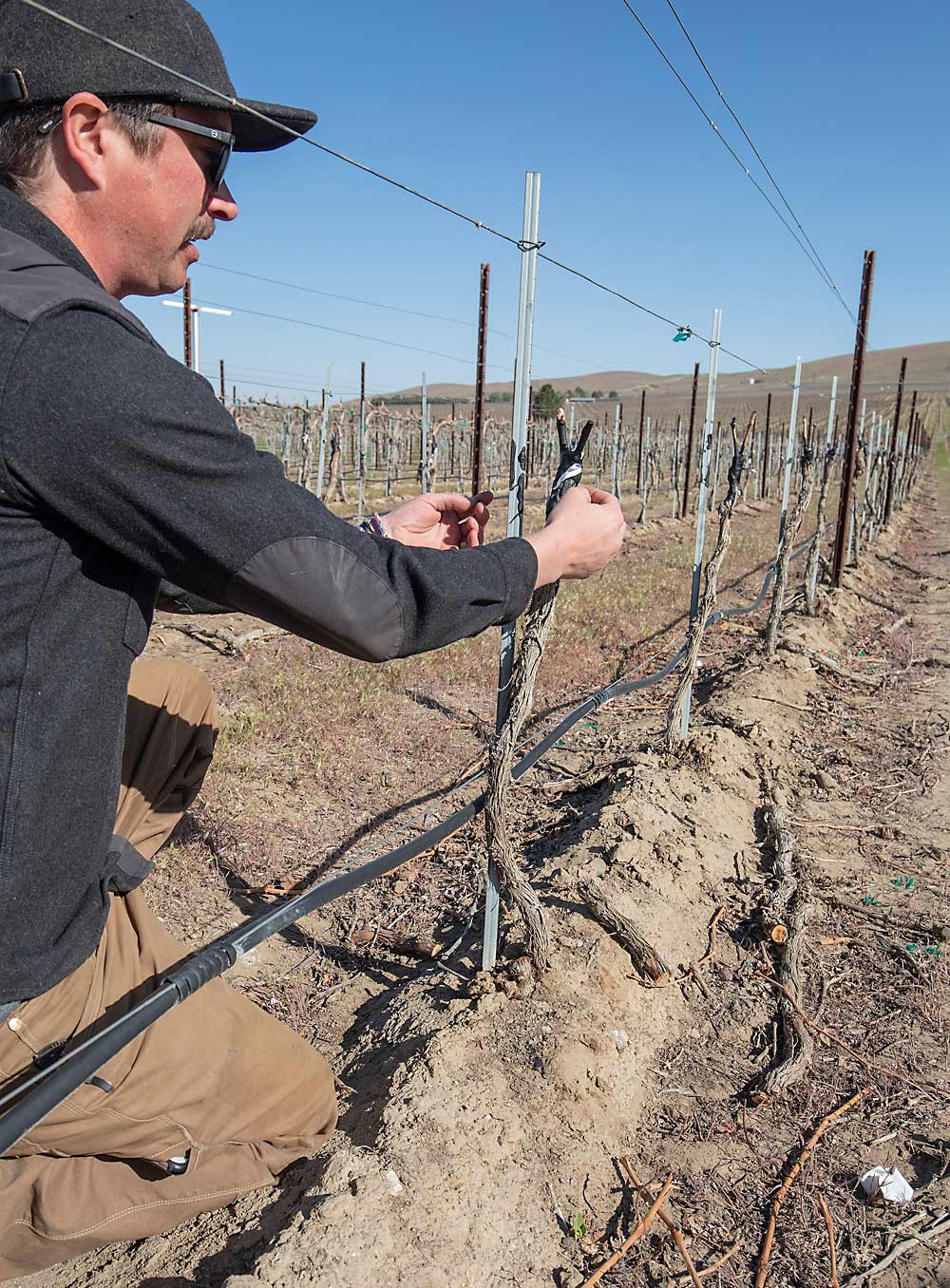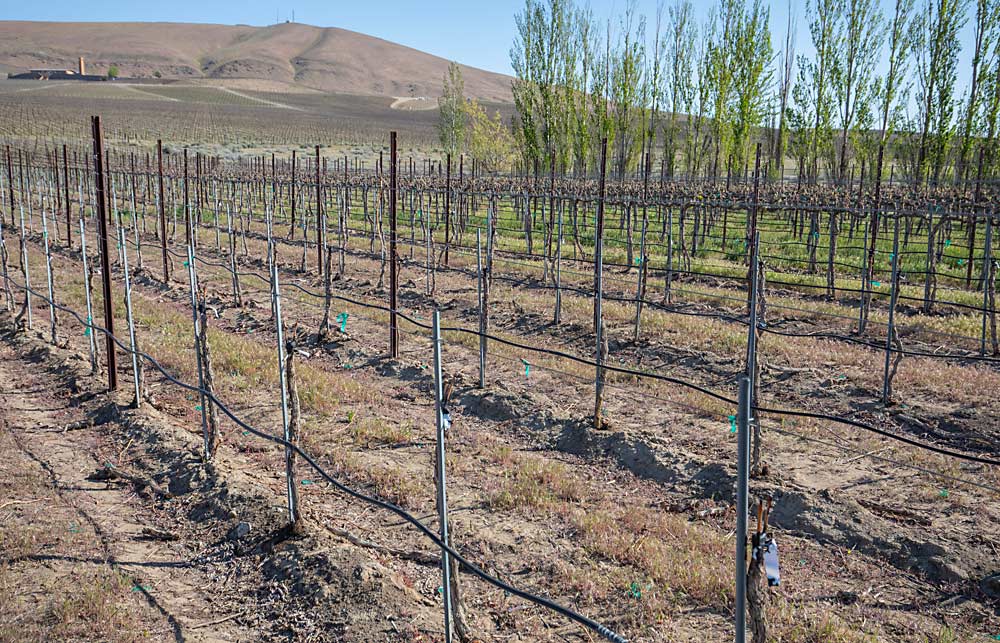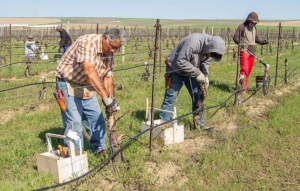
Facing an oversupply of Cabernet Sauvignon, more Washington grape growers have opted to graft existing vineyards into new varieties.
“The economics of it are very good compared to replanting,” said Dick Boushey. He estimated the cost of grafting a 5-acre vineyard at $20,500, compared with $34,000 to replant the same 5 acres, which would then require more training and more time to come into production.
Grafting requires precision. “When you do it right, you’ll be in full production in two years. I’ve picked 3 tons per acre in the next year,” he said. “I would reluctantly recommend it, but you have to do everything properly.”
Doing it right is easier said than done, according to Boushey and two other growers, Lacey Lybeck and Al Fountain, who shared their experiences during the Washington State Grape Society meeting in November. One challenge is the lack of local expertise; most Washington growers rely on the same California-based company, which is stretched thin with growing demand for grafting service.
While Boushey shared promising cost estimates and tips for success, Fountain, owner of Kennewick-based Fountain Vineyard Management, shared a cautionary tale. In 2021, he set out to graft 200 acres of Cabernet to Chardonnay, but ended up with only about 70 percent take. Now, he will pull out another 200 acres he had hoped to graft as well and plans to replant instead.

Fountain and Boushey both worked with the same grafter, Raul Rodriguez, who brings a crew up from California to work in Washington every spring.
But in Fountain’s case, Rodriguez brought a small crew, and it was a big job. Hiring more workers locally didn’t work well, Fountain said.
“The people he brought from California did a great job. But one row would have 90 percent take and another would have 40 missing in a row,” Fountain said.
He proved that theory again in 2022. Rodriquez brought a larger team but had to move on to another job before they finished Fountain’s acreage; the local crew Fountain hired to finish the work ended up with only about 60 percent take.
“The whole key is the guys have to know what they are doing when they make the cuts,” Fountain said.
Lacey Lybeck, vineyard manager at Sagemoor Vineyards, shared her experience grafting on a smaller scale.
“We used it as an opportunity to try out some new varieties, including Savatiano and Aglianico,” she said. “It’s a great way to try a new variety and be able to taste what your site provides and if it complements that variety.”
Some varieties seem to have more issues with take than others, she added.
Boushey said he has worked with Rodriguez over the past 12 years and has learned how to plan a project and tend the vines afterward to maximize success.

“I like to graft as close to the wire as possible,” he said, which makes it easier to tie and fill space. Training early helps to protect the grafts from wind damage.
Grafting close to the wire can also be easier on crews, said Markus Keller, viticulture professor at Washington State University.
Keller walked attendees through the grafting process, which starts with scion wood. He recommends thorough disease testing or ordering certified wood from a nursery. And he said not to graft onto infected vines.
Dormant cuttings should be about the thickness of a pencil and have four to five buds. Bundles of cuttings should go in a cold room and be stored in a way that keeps them moist — such as wrapped in damp newspaper or sawdust — but not soaked, Keller said.
Boushey said he collects dormant budwood in the late fall, before the temperature is too cold, and layers the sticks into a bin for the winter. The grafters then cut the wood into two bud sticks right before they graft. “You want two buds pushing,” he said.
Ideally, growers should schedule grafting for a month or two before budbreak, Keller said.
“I usually recommend irrigating before grafting, to make sure they have enough water in the soil so as not to dry out the wood during the healing process,” he said.
While there are many different grafting styles, depending on the shape of the cuts, the cambium of the scion wood must line up with the cambium of the trunk, or the graft won’t take, Keller said
Suckers on the trunks will compete with the scion for growth, so he recommends removing them; however, he added the caveat that older vines with large root systems can push a lot more vigor than the new grafts can handle, so leaving the suckers for a while may help in that case.
“Crop quickly back to the level that the vine was at before your graft and use the same pruning method within two or three years,” Keller said. “You still have that old root system, and you want the vine to get in the habit of producing fruit as quickly as possible.”
Keller also offered two potential pitfalls: crown gall infection and budwood that dries out or becomes waterlogged during storage.
Lybeck said she regularly checks for signs of crown gall and has seen grafts struggle when the summer heat has arrived abruptly, while Fountain said he had better success when he irrigated before grafting.
Until the grafts callus over, Boushey recommends making scoring cuts below the grafts, to deflect sap that can sometimes push out fresh grafts. As the season progresses, the grafted vines need training, regular suckering and irrigation, Boushey said.
“You think you won’t need a lot of water because there’s no fruit, but you need to keep the plant healthy,” he said.
—by Kate Prengaman







Leave A Comment